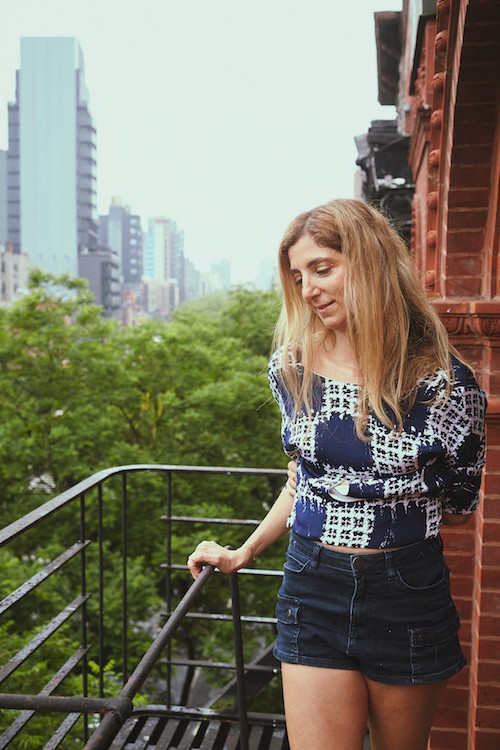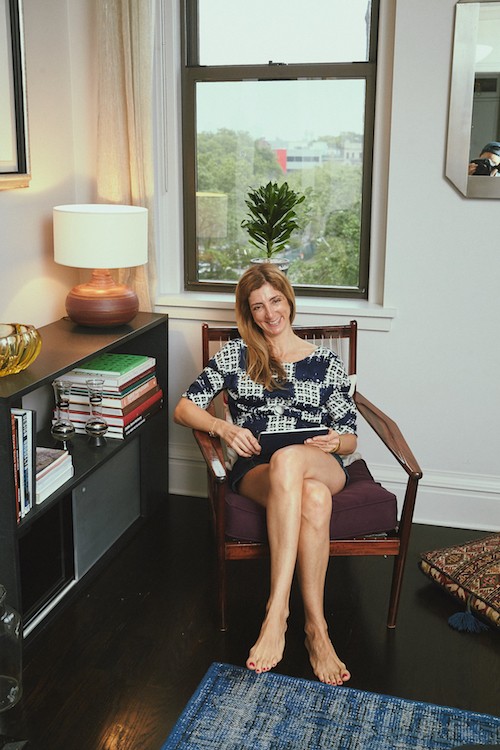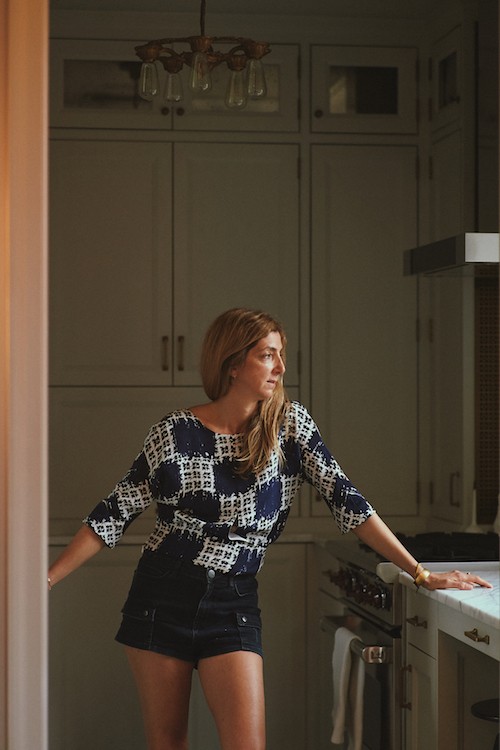“You can take the girl out of the club but you can’t take the club out of the girl. I’m a total raver,” says Lebanese-born and Parisian-raised Rima Rabbath. With an average of 70 (very cool) students per class at the Jivamukti Yoga Center, Rima is hands-down the hottest, hippest and holiest yoga teacher in New York City.
COOLS was lucky to have a chat with her in her chic East Village apartment were she flooded us with insight on music, raves, and how to remain a student of life in this hectic but also magical place that we New Yorkers call our home.
Imagine yourself walking into a yoga class with 70 people in the room five days a week. That’s what Rima Rabbath and all her students experience on a regular basis and believe it or not, it’s quite a transformational, high intensity (who ever said yoga wasn’t cardio?!), mind-blowing and I would even dare to say, rave-like experience. The Jivamukti Yoga Center on Broadway and 13th street was founded by Sharon Gannon and David Life—two yoga masters, artists, and authors with a commitment to yoga as a path for spiritual activism. It’s a yoga center that draws in creatives, artists, and people from all walks of life who have a deep curiosity and are seeking a solid yoga practice. As the musician Sting says, “David and Sharon have inspired and encouraged us to think of yoga not just as a system of exercises but as a door to the infinite.”
We sat down with Rima to listen to her play the harmonium and asked her a few questions.
COOLS: Many people are drawn to your classes because of your music. How did your journey with electronic music begin?
Rima Rabbath: I’m really into music, mostly electronic music, and I have incredible friends who’ve introduced me to that genre who have taken me by the hand to places like Twilo in NYC and many other clubs around the world. I’ve even travelled to London just to go to FABRIC for one night [laughs]. There’s something about the dance floor where you can be vulnerable and allow yourself to be exposed. The movement of the body gives rise to such confidence, presence, and there’s a sense of ease of being in your own body, which I think the yoga practice also gives rise to.
One of the pillars of the Jivamukti Method is Nada, the yoga of sound, which is about listening but also about using sound as a way to tap into the physical body which is made of energy. Because of the flexibility of the Jivamukti method I am able to introduce tracks and beats into a class that you would listen to at midnight or 4am on the dance floor. There’s a method to putting together a playlist; it has to work, it takes time and it is a very important component of the class.
I finally got on Spotify so anyone can listen to some of the playlists I play in class. However, I do buy all my music so when I try to recreate my playlists on Spotify, a lot of times I can’t find certain tracks.
COOLS: Aside from electronic music, you also play songs with lyrics. Isn’t that a distraction to many because of the associations we create to words?
RR: Music is universal and it allows you to drop into embodied presence; into the now. Even if you know the lyrics of a song, and it makes you nostalgic of a time that is not anymore, because you’re practicing yoga]\ as you listen to it, you’re relating to the song in a different way. Meaning that if a song makes you feel nostalgic or reminds of you of something, because you’re listening to it as you move, it’s not so emotionally loaded. Because of the spaciousness of the practice, there is space for a new interpretation to be done by the nervous system connected to that track. You’re re-connecting to that song in a way that is more open, more fresh, and less loaded. Less loaded is a good term.
COOLS: How can moving on your mat help with getting over our habitual mind patterns, fears, traumas and even injuries?
RR: On your mat you are able to reconnect to old traumas, and injuries in a different way. For example, if you tend to you relate to your psoas muscle being contracted and tight out of posttraumatic stress disorder (PTSD) , [when you practice] you can relate to that contraction in a way that’s safe because you’re on your mat. That’s why I love to say that the mat is the magic carpet because your perception of anything has the potential to shift on this carpet; on this mat. And then you can fly with whatever it is that you choose to fly with and take with you.
COOLS: Coming from Beirut, why did you choose New York City as your home?
RR: That’s a good question. I think there are two ways of reacting to one’s upbringing and to the environment in which one grew up. One is to do the complete opposite, and the second one is to take what’s familiar and work with it in a way that’s intelligent and playful. Growing up in Beirut in the 80s was really chaotic and violent, but it also had all the wonderful aspects of a city that has uncertainty and chaos. Not that Beirut is similar to New York, but this urban jungle cliche of New York, or the excitement that one feels here– the incessant noise, the feeling that people are coming at you– all of that was a familiar feeling when I first got here. I felt a sense of comfort and familiarity with the excitement that New York had to offer. I thrive in that kind of atmosphere, in fact, there is this saying that Beiruties– people living in Beirut– can only function properly if there’s a certain amount of friction or tension. New York gave me the opportunity to experience a completely new city with those familiar elements.
COOLS: What brought you here?
RR: I chose New York because I came for an MBA at NYU in my early twenties, and then I worked in corporate America, at Palmolive Colgate in Midtown after a few years: which was also super exciting.
COOLS: How is it to be a yoga teacher and live in such a stressful and hectic place like New York?
RR: Now I live a completely different life. I don’t have a regular schedule, so I never hit rush hour. I’m so lucky and I sort of have to pinch myself that I live in a crazy busy noisy city, without being in contact with all that noise and rush. I can feel it and I have experienced it in the past, but now it’s different. I relate to New York City in a different way that most people relate to. This gift that I have which is my lifestyle within a chaotic city, allows me to enter into a room and teach from a place of spaciousness and a space of abundance, versus a place of me just trying to rush and hurry like everyone else.
COOLS: How long have you been teaching yoga?
RR: I started teaching in February 2006. I’ve been teaching for twelve and a half years.



COOLS: How did it all kick off for you?
RR: It’s sort of miraculous, I guess I do feel that teaching Jivamukti Yoga is my calling. It’s my heart method; the one I’m most at home with and most genuine with when I teach.
I started with four people in class in February 2006, and it quickly built up. Because students at the studio had seen me practice for so many years (started practicing in the Summer of 2000), I was a familiar face to people even before I started teaching. This contact with me as a practitioner created this pull with people to then come to my classes. But honestly I don’t know, some things you don’t know. I’ve worked quite hard and put my heart into teaching, so don’t ask me why!
COOLS: Who are your teachers?
RR: My main teachers or root teachers are Sharon Gannon and David Life, the co-founders of Jivamukti Yoga. I met them in 2000 when I went to my first Jivamukti Yoga class. At the time I wasn’t into yoga at all. More recently I’ve been studying with Pema Chodron, mainly weekends at the Omega Institute and I’ve taken the Refuge vows in the Shambala Tradition.
COOLS: What are the Shambala Refuge Vows?
RR: Shambala vows are reminders of our potential. It’s about becoming more aware, more mindful, and more awake to life. Refuge vows are about taking refuge in the Buddha, the Dharma and the Sangha. I took them because I was curious and interested and wanted to go deeper into the teachings & practices of Buddhism. When you take a vow you make a commitment to yourself and to others I feel it’s important. It’s more than just engraving your name on the sand and the water washing it away; its deeper than that.
COOLS: You speak about remaining a student in order to master life. Can you expand on this?
RR: The [yoga] practice keeps you honest. Day after day you come to your mat and you watch yourself being pulled by thoughts, by the places where we feel comfortable and the places where we feel uncomfortable. There are days when you don’t want to practice, or days that you see yourself sucking at your practice, and it’s part of the path. Life has ebbs and flows and so does our practice, but because you do it regularly and you stay with it, you become more aware of the ups and downs and try not to invest so much in them. You invest a lot in the practice because it’s what will help you work with the ups and downs, instead of struggling against the ups and downs. Being a student (being in a class) and having a teacher, encourages you to not give up on yourself. Just the doing of it is a way of not giving up on yourself. Which actually increases your confidence. Being a student keeps you teachable, receptive, open, and curious.
COOLS: Would you say that as a teacher you are a student too?
RR: As a teacher you need the qualities of the student. You have to nourish yourself, see, and listen to students and to what their needs are. You have a plan in life, but the plan has to be malleable, porous and flexible. You have the skeleton
COOLS: How can someone cultivate a practice even if they don’t do yoga?
RR: A practice can be anything that you do in a consistent basis with some sort of awareness, discipline, and warmth. It doesn’t have to be meditation or yoga. A practice embedded in practice is the idea of doing something on a consistent basis; of doing it in a way that is steady and where there is also heart and warmth in it. So your work can be your practice. Your work shows back to you, and reflects back to you how you’re dealing with the components of that work. It shows you how you are relating to it. Are you constantly irritated going to work? Are you always upset and gloomy? If that’s the case, watch yourself and see how you can turn it around. It’s not easy.
A practice is not a habit, because you don’t do something habitually it with awareness, heart, or warmth. So it really can be anything: writing, painting, biking, taking a walk, dancing, relating with your kid, whatever that is that you do, as long as you bring your full conscious attention to it, you can turn it into a practice.
COOLS: How can being a student of life become a doorway to more awareness?
RR: We are students of life and life is the greatest teacher. In order for life to teach us we have to take the humble seat of the student. Sharon Gannon speaks about humility and how it is a magical elixir. Magic is a shift in perception. If you’re humble enough to allow yourself to be taught by life, then magic might arise in your world and you will see the world in a different lens.
There is a sense of clarity, curiosity, wonder, and a sense of freshness when you become a student. There is less boredom, and less doing on automatic pilot.